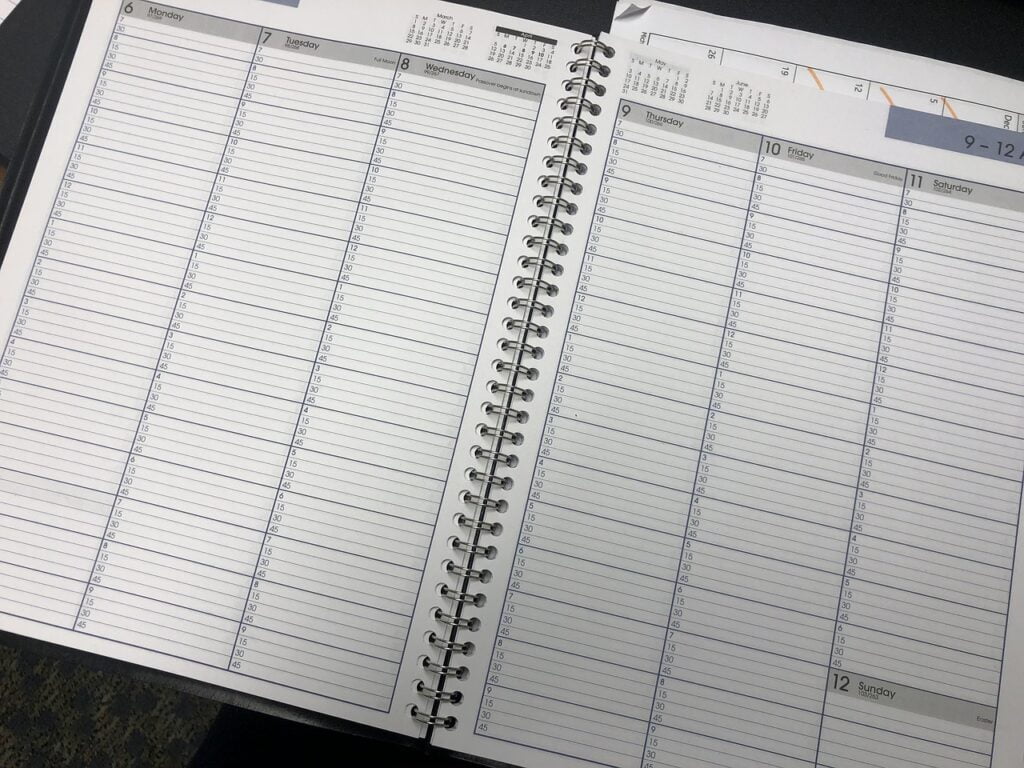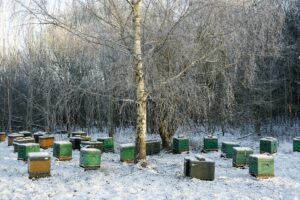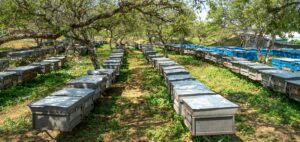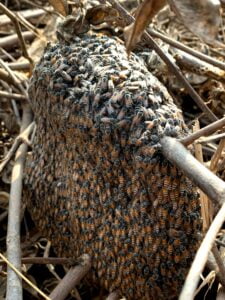Urban beekeeping is becoming increasingly popular as city dwellers look for ways to engage with nature and contribute to local ecosystems. Starting urban beekeeping involves understanding the basics of apiculture and selecting the right gear to ensure a successful beekeeping experience. Whether you’re a complete beginner or have some beekeeping experience, this guide will provide you with essential tips on how to start urban beekeeping, including an overview of key beekeeping gear and best practices. Learn how to start urban beekeeping with this guide.

Table of Contents
1. Choose the Right Hive to Start Urban Beekeeping
Consider Hive Size and Type
6 Types of Hives – Bee Keeping – Proven Apiculture Practices
When starting urban beekeeping, choosing the right hive is essential for keeping bees effectively. For small spaces, a top-bar hive is often a good choice due to its compact size and ease of use. On the other hand, a Langstroth hive, which is larger, can offer higher honey yields but requires more space. Consider your space constraints and beekeeping goals when making your selection.
- Top-Bar Beehive: Ideal for urban settings with limited space; easy to manage. This beehive type is compact, simple to handle, and well-suited for beginners and those with small gardens. Its design allows for easy inspection and maintenance, making it a practical choice for urban environments.
- Langstroth Beehive: Offers higher honey production but needs more room and maintenance. This traditional hive is widely used due to its efficient honey extraction and management system. However, it requires more space and regular upkeep, which may be challenging in a confined urban setting.
- Warre Hive: Known for its vertical design and minimal intervention approach. The Warre hive is a good option for urban beekeepers who prefer a more natural beekeeping method. It requires less frequent management and is designed to mimic the bees’ natural nesting habits.
- Flow Hive: Features a unique honey harvesting system that allows for extraction without disturbing the bees. This hive is ideal for urban beekeepers looking for a convenient honey harvesting solution. However, it may have a higher initial cost and requires careful management to ensure proper function.
- Vertical Hive: A variant of the Langstroth hive, it provides additional space by stacking multiple boxes vertically. This design can be advantageous for urban settings where horizontal space is limited, though it may require more maintenance and management.
- Skep Beehive: Traditional and visually appealing, but less common in modern beekeeping. Skep hives are made from woven straw and are often used for aesthetic purposes in urban beekeeping. They are not as practical for regular honey extraction or hive management compared to more modern hive types.
- Beespace Hive: Designed with specialized spacing to mimic natural bee conditions. This beehive type can be beneficial for urban beekeepers who want to create a more natural environment for their bees. It requires understanding of specific management practices to ensure the bees’ well-being.
Assess Your Space Constraints
Before placing your hive, measure your available space to ensure it will fit comfortably. Urban environments may have unique space limitations, so it’s crucial to ensure your chosen hive complies with any local regulations or space restrictions.
- Space Requirements: Measure carefully to avoid overcrowding.
- Local Regulations: Verify space limits and zoning laws for beekeeping in your area.
2. Select a Strategic Location for Your Beehive
Find a Safe and Accessible Spot
Position your hive in a location that is both safe for the bees and accessible for you. Avoid placing the hive near high-traffic areas where it might be disturbed by passersby. A quiet, secure spot will help your bees thrive and make your maintenance tasks easier.
- Safety: Keep the hive away from busy pedestrian zones.
- Accessibility: Ensure easy access for regular inspections and maintenance.
Ensure Proper Sunlight and Shelter
Your hive should receive adequate sunlight, preferably in the morning, to help warm it up and keep the bees active. Additionally, providing shelter from extreme weather conditions, such as strong winds or heavy rain, will help protect your hive and maintain a stable environment.
- Sunlight: When you start urban beekeeping, select a spot with morning sun exposure to help warm the hive and stimulate bee activity early in the day. Morning sun can enhance foraging efficiency and help regulate the hive’s temperature. Avoid locations with too much afternoon sun as it can overheat the hive during summer.
- Morning Sun: Provides early warmth, aiding in hive activity and productivity.
- Avoid Afternoon Sun: Too much direct afternoon sun can lead to overheating, especially in summer.
- Shelter: Protect your hive from harsh weather conditions by using natural or artificial barriers. Shelters can help shield the hive from strong winds, heavy rain, and excessive sun, ensuring a stable and comfortable environment for the bees.
- Natural Barriers: Utilize trees, shrubs, or fences to provide windbreaks and protection from rain.
- Artificial Barriers: Consider installing hive covers, screens, or constructing a small shed to offer additional weather protection.
- Elevation: Place your hive slightly elevated to prevent water accumulation and to reduce the risk of pests. A well-drained spot ensures that the hive remains dry and reduces the likelihood of mold or rot.
- Elevation: Position the hive on a stand or platform to keep it off the ground.
- Drainage: Ensure the location has good drainage to prevent water from pooling around the hive.
- Accessibility: Choose a location that is easily accessible for regular inspections and maintenance. Ensure there is enough space around the hive for you to work comfortably and for the bees to fly in and out without obstruction.
- Space Around Hive: Allow sufficient space for inspecting and maintaining the hive.
- Easy Access: Ensure you can easily reach the hive for feeding, monitoring, and harvesting honey.
- Proximity to Forage: Position your hive near a good source of forage, such as gardens, wildflowers, or fruit trees. A nearby food source can boost hive productivity and overall bee health.
- Food Sources: Place the hive near flowering plants or agricultural areas to provide ample forage.
- Pollination Opportunities: Ensure the area supports a diverse range of plants to benefit the bees.
- Avoid High-Traffic Areas: Ensure the hive is located away from high-traffic areas to minimize disturbances. Bees can become stressed if their flight paths are frequently interrupted by human activity.
- Minimize Disturbance: Place the hive in a quiet area away from footpaths and busy zones.
- Bees’ Flight Path: Consider the bees’ flight patterns to avoid interference from people or pets.
- Legal and Safety Considerations: Check local regulations and zoning laws to ensure that beekeeping is permitted in your chosen location. Comply with any specific requirements or restrictions to avoid legal issues.
- Regulations: Verify local beekeeping rules and obtain necessary permits.
- Safety: Ensure the location adheres to safety standards to prevent potential conflicts with neighbors or by-laws.
3. Understand Local Regulations and Permits
Research Local Beekeeping Laws
Urban apiculture regulations can vary widely. Research local laws and ordinances to ensure that you are compliant with any required permits or restrictions. This step is crucial to avoid fines or legal issues and to ensure that your beekeeping activities are in line with city regulations.
- Permits: Apply for any necessary beekeeping permits.
- Regulations: Understand and follow local beekeeping laws and restrictions.
Comply with Zoning Requirements
In addition to general beekeeping regulations, your hive placement must adhere to zoning laws. Check if beekeeping is allowed in your zoning area and be aware of any specific rules regarding hive placement or size.
- Zoning Laws: Confirm that beekeeping is permitted in your zone.
- Neighbor Relations: Be aware of potential conflicts and communicate with nearby residents if needed.
4. Invest in Quality Beekeeping Gear

Essential Gear for Beginners
10 Proven Honey Bee Supplies Every Beekeeper Needs
Investing in high-quality beekeeping gear is essential for your success as an urban beekeeper. Key items include a well-fitting bee suit, durable gloves, and a reliable hive tool. Proper gear will ensure your safety and make hive management more efficient.
- Bee Suit: Provides essential protection against bee stings and ensures your safety while working with your hive. A well-fitting bee suit covers your entire body and includes a veil to protect your face and neck. It is crucial for preventing stings and allergic reactions, especially when you are new to beekeeping or working with a particularly defensive hive.
- Full Coverage: Includes a jacket, pants, and veil to protect against stings from all angles.
- Ventilation: Look for suits with ventilation to keep you cool during inspections.
- Durability: Choose a suit made from durable, tear-resistant material to withstand wear and tear.
- Fit: Ensure the suit fits well and is comfortable to allow for ease of movement while inspecting the hive.
- Hive Tool: A multi-purpose tool essential for inspecting and maintaining the hive. It helps in prying apart hive boxes, scraping off excess wax or propolis, and managing frames. The hive tool is critical for accessing the interior of the hive and performing regular maintenance tasks.
- Design: Typically features a flat end for prying and a curved end for scraping.
- Material: Made from strong, durable metal to handle the demands of hive management.
- Ease of Use: Choose a tool with an ergonomic handle for better grip and comfort during use.
- Bee Gloves: Designed to protect your hands and forearms from stings while handling bees. They should be made from thick, durable material and have a snug fit to prevent bees from crawling inside.
- Material: Look for gloves made from leather or thick synthetic materials.
- Elastic Cuffs: Ensure the gloves have elastic or adjustable cuffs to keep them securely in place.
- Comfort: Choose gloves that allow for dexterity while handling hive components.
- Veil: Provides a protective barrier for your face and neck to prevent bee stings. It is a crucial component of your bee suit and should offer clear visibility and comfort.
- Mesh: Opt for a veil with fine mesh that provides visibility and ventilation while keeping bees out.
- Attachment: Ensure the veil attaches securely to your bee suit to prevent any gaps.
- Comfort: Look for adjustable features to ensure a snug and comfortable fit.
- Smoker: Used to calm bees and make hive inspections safer. The smoke masks alarm pheromones and reduces the likelihood of aggressive behavior from the bees. It is essential for maintaining a peaceful environment while working with the hive.
- Fuel: Use a combination of wood chips, paper, or pine needles for effective smoking.
- Design: Choose a smoker with a heat-resistant, insulated design to protect your hands.
- Airflow: Look for a smoker with a bellows system for controlling smoke output.
- Bee Brush: Gently brushes bees off frames and equipment without harming them. It is useful for cleaning frames during inspections and honey extraction.
- Brush Type: Use a soft-bristled brush to avoid damaging bees or comb.
- Handle: Choose a brush with a comfortable, ergonomic handle for ease of use.
- Cleaning: Ensure the brush is easy to clean and maintain to prevent cross-contamination between hives.
- Frame Gripper: A tool used to safely lift and handle frames without damaging the bees or the comb. It provides a secure grip on frames, making hive inspections and honey harvesting more manageable.
- Design: Features a handle and gripping mechanism to securely hold frames.
- Material: Made from durable plastic or metal for long-lasting use.
- Ease of Use: Ensure the gripper is easy to operate and provides a firm hold on frames.
- Honey Extractor: A device used to extract honey from frames. It is available in both manual and electric models and is essential for harvesting honey efficiently.
- Type: Choose between manual or electric extractors based on your volume and budget.
- Capacity: Select an extractor with a capacity that matches your hive size and honey production needs.
- Ease of Cleaning: Ensure the extractor is easy to disassemble and clean.
- Bee Feeder: Provides supplemental food to bees when natural forage is scarce. It can be an essential tool during periods of low nectar flow or for boosting hive strength before winter.
- Type: Options include top feeders, entrance feeders, and hive-top feeders.
- Capacity: Choose a feeder with an appropriate capacity for your hive’s needs.
- Design: Look for feeders that are easy to refill and clean.
Consider Long-Term Durability
Choose beekeeping equipment that is built to last. Durable materials and well-made gear will save you money in the long run by reducing the need for frequent replacements and repairs. Prioritize items that are easy to clean and maintain.
- Durability: Opt for gear made from robust and long-lasting materials.
- Maintenance: Select equipment that is simple to clean and upkeep.
5. Monitor and Manage Hive Health Regularly
12-Month Beekeeping Schedule: Essential Roadmap to Success
Regular Inspections
Regular hive inspections are crucial for maintaining a healthy colony. During inspections, check for signs of disease, pests, or inadequate food supply. Addressing issues promptly can prevent more significant problems down the line.
- Disease Monitoring: Look for symptoms of common bee diseases, like Nosema or Varroa mites.
- Pest Control: Regularly check for pests such as beetles and wax moths.
Implement Preventative Measures
Preventative measures are key to avoiding common beekeeping problems. Implement practices such as swarm prevention techniques and regular hive maintenance to keep your colony healthy and productive.
- Swarm Prevention: Use methods like regular hive inspections and adding extra space to prevent swarming.
- Colony Maintenance: Ensure the hive has a strong, healthy queen and adequate resources.
- Ultimate Swarm Prevention Guide: 12 Proven Beekeeper Tips
6. Provide Adequate Food and Water for Your Bees

Ensure a Reliable Food Source
Providing a steady food supply is vital for your bees, especially during times of scarcity such as winter or early spring. Supplemental feeding with sugar syrup or pollen patties can support your hive when natural forage is limited.
- Supplemental Feeding: Use sugar syrup or pollen patties to support bee nutrition.
- Natural Forage: Encourage local plant growth to provide additional food sources.
Maintain Clean Water Sources
Bees need access to clean water to survive. A shallow water source with pebbles or a dedicated bee waterer can prevent drowning and provide a reliable water supply for your colony.
- Water Source: Use a bee waterer or a shallow dish with pebbles to provide water.
- Water Maintenance: Regularly clean and refill the water source to prevent contamination.
7. Protect Your Hive from Urban Pests

Identify Common Urban Pests
Urban environments can attract pests that pose a threat to your hive. Common pests include ants, mice, and hornets. Identifying and addressing these pests early can prevent damage to your hive and protect your bees.
- Ants: Use ant barriers or traps to keep ants away from the hive.
- Mice: Secure the hive to prevent mice from entering and causing damage.
Implement Pest Control Measures
Effective pest control is essential for protecting your hive. Regularly check for signs of infestation and take action using safe and effective pest control methods to manage any issues.
- Pest Monitoring: Inspect for pests during routine hive checks.
- Control Methods: Utilize safe pest control products and methods to protect your bees.
8. Plan for Seasonal Changes in Urban Environments
Adjust Hive Management for Seasons
Urban beekeeping requires adjusting your hive management practices according to the seasons. For example, increase food supplies before winter and prepare the hive for colder temperatures to ensure your bees remain healthy.
- Seasonal Feeding: Provide extra food in the fall to prepare for winter.
- Hive Insulation: Add insulation or windbreaks to protect the hive from extreme cold.
Prepare for Extreme Weather
Winter Bee Hive Wraps: 6 Step Beginner Guide to Protect Bees
Prepare your hive for extreme weather conditions typical in urban environments. Implement measures such as protective covers or shades to shield your hive from heat waves or heavy rains.
- Weather Protection: Use hive covers or shades to protect against excessive heat.
- Rain Prevention: Ensure proper drainage to prevent water damage during heavy rains.
9. Educate Yourself on Urban Beekeeping Challenges
Learn from Experienced Beekeepers
Engage with experienced urban beekeepers to gain valuable insights into managing a hive in a city environment. Join local beekeeping groups, attend workshops, and participate in forums to expand your knowledge.
- Local Groups: Connect with beekeeping associations and clubs.
- Online Resources: Explore online forums and educational materials to learn from others.
Stay Informed on Best Practices
Keep up-to-date with the latest best practices and innovations in urban beekeeping. Regularly read articles, attend seminars, and follow research to continuously improve your beekeeping techniques.
- Workshops: Attend beekeeping workshops and conferences for hands-on learning.
- Research: Read recent studies and articles to stay informed on new practices.
10. Engage with the Local Beekeeping Community
Network with Other Beekeepers
Building connections with fellow beekeepers can provide support and exchange of valuable information. Join local beekeeping associations or online communities to benefit from shared experiences and advice.
- Beekeeping Associations: Participate in local or regional beekeeping groups.
- Online Communities: Engage in beekeeping forums and social media groups to network.
Share Your Experiences
Contributing your experiences and knowledge helps build a supportive beekeeping community. Share your successes and challenges through social media or local events to foster collaboration and learning.
- Social Media: Post updates and tips about your beekeeping journey.
- Local Events: Participate in community events to share your beekeeping insights.
11. Implement Effective Hive Management Practices

Develop a Management Plan
Create a comprehensive management plan to ensure your hive receives consistent care. Include details such as inspection schedules, maintenance tasks, and record-keeping practices to streamline hive management.
- Inspection Schedule: Set regular intervals for hive inspections.
- Maintenance Tasks: List essential maintenance tasks and deadlines to follow.
Use Technology to Assist
Leverage technology to enhance your hive management practices. Tools like hive monitoring systems or mobile apps can help you track hive conditions and manage tasks more efficiently.
- Hive Monitoring: Install sensors or cameras to monitor hive health remotely.
- Management Apps: Use apps to schedule inspections and track hive activities.
12. Promote Urban Beekeeping Awareness and Benefits
Educate the Public
Raising awareness about the benefits of urban beekeeping is essential for encouraging more people to get involved. Organize workshops, public talks, or community events to share knowledge about how beekeeping supports local ecosystems, enhances urban biodiversity, and contributes to sustainable food systems. Providing information about the positive impact of bees on the environment can help foster a supportive community for beekeeping.
- Workshops: Host educational events to teach people about the benefits and practices of urban beekeeping.
- Public Talks: Give presentations to local schools, community groups, or at local events to raise awareness.
- Educational Materials: Distribute brochures, flyers, or create social media content that highlights the importance of bees.
Advocate for Urban Beekeeping
Support initiatives and policies that promote urban beekeeping and sustainable practices. Engage with local officials and participate in advocacy efforts to shape favorable beekeeping regulations and encourage more urban residents to consider beekeeping. Your advocacy can help create a more beekeeping-friendly environment and support the growth of urban beekeeping practices.
- Policy Advocacy: Work with local government to develop or support beekeeping-friendly policies and regulations.
- Community Involvement: Participate in or organize local campaigns that promote the benefits of beekeeping and the protection of bees.
- Support Local Initiatives: Back local projects or initiatives that aim to integrate beekeeping into urban planning and sustainability efforts.
Additional Resources
USDA PROGRAMS AND RESOURCES TO SUPPORT BEEKEEPERS
Conclusion
Starting urban beekeeping can be a rewarding experience, offering benefits for both you and your local environment. By understanding how to start urban beekeeping, investing in the right beekeeping gear, and following best practices, you can set yourself up for success. Whether you’re a beginner or looking to expand your knowledge of apiculture, these tips will guide you on your journey to becoming a successful urban beekeeper.



